Family : Canidae

Texte © Dr. Lucrezia Callocchia

English translation by Mario Beltramini
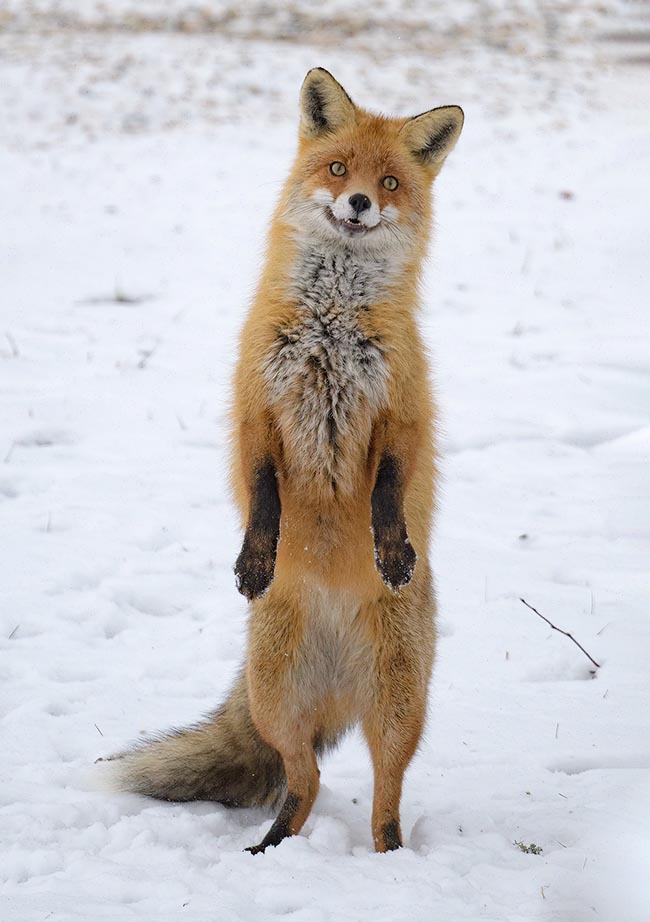
Symbol since old times of cunning and deception in many legends and common sayings, the Red fox (Vulpes vulpes) covers a vast range and is now present in all the boreal hemisphere but in the deserts of USA, Mexico and Sahara © Armandas Naudžius
The Red fox, Vulpes vulpes (Linnaeus, 1758), is a medium sized mammal belonging to the order Carnivora and to the family of the Canidae, of which is the most diffused wild member.
Since ancient times, this species has always had a strong link with man, so much so that it has become a symbol of cunning and deception in many legends and ways of saying.
The generic term Vulpes, repeated also for the species, is the name with which Romans did call the fox, a common name that bears presently an allegorical sense in various languages, in English, for instance, the name “fox” is utilized also as a verb and means “to deceive”.
From the Greek name “alopex” comes the term alopecia, a disease that causes the loss of the hairs, with a possible reference to the fact that in spring the fox effects a moult that thins out the soft winter hair.
On the other hand, the presence of the fox is often considered as a problem for man, because of its interest in small domestic animals, especially poultry.
For such a reason, this animal has often been persecuted and hunted by men with cruel traps.
The genus Vulpes is formed by 12 species, of which Vulpes vulpes is the only one present in Italy.
Zoogeography
Based on the fossil findings, it has been established that the genus Vulpes originated in North America in the Miocene about 9 million years ago, to then expand towards Eurasia and effect different speciations and some generating animals like the Red fox and the Arctic fox (Vulpes lagopus).
Later, during the Upper Pleistocene, these species went back to North America, where nowadays they are still present.
Presently, the red fox is diffused all over the whole boreal hemisphere but in the deserts of the USA, Mexico and Sahara.
The link with man has led this species to expand with him; in particular, by the end of 1700, it has been introduced also in Australia to promote fox hunting, becoming later an invasive species, detrimental to many native species, such as marsupials and birds.
In Italy, the distribution range of the red fox covers the whole territory, excluding the smaller islands.
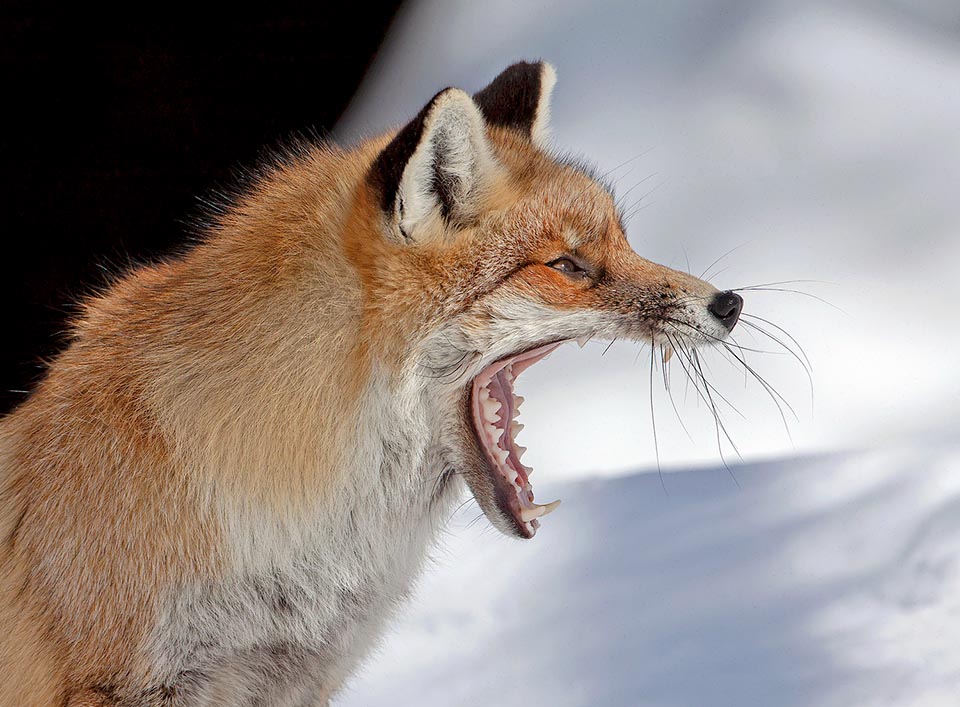
The snout is particularly elongated, the ears triangular and the dentition is not too far from the typical one of canids but with teeth proportionally smaller © Paolo Lombardo
In recent times we have also seen an expansion in the flat areas characterized by intensive agriculture.
Such a wide distribution results in a great morphological variability that has led to the recognition of as many as 45 subspecies of Vulpes vulpes.
These are divided in two categories: the northern red foxes, big and with intense colours, and the southern red foxes of the desert that include three Asian subspecies characterized by smaller dimensions, longer legs and bigger ears. The subspecies present in Italy are Vulpes vulpes crucigera, in the peninsula and in Sicily, and Vulpes vulpes ichnusae endemic to Sardinia and present also in Corsica.
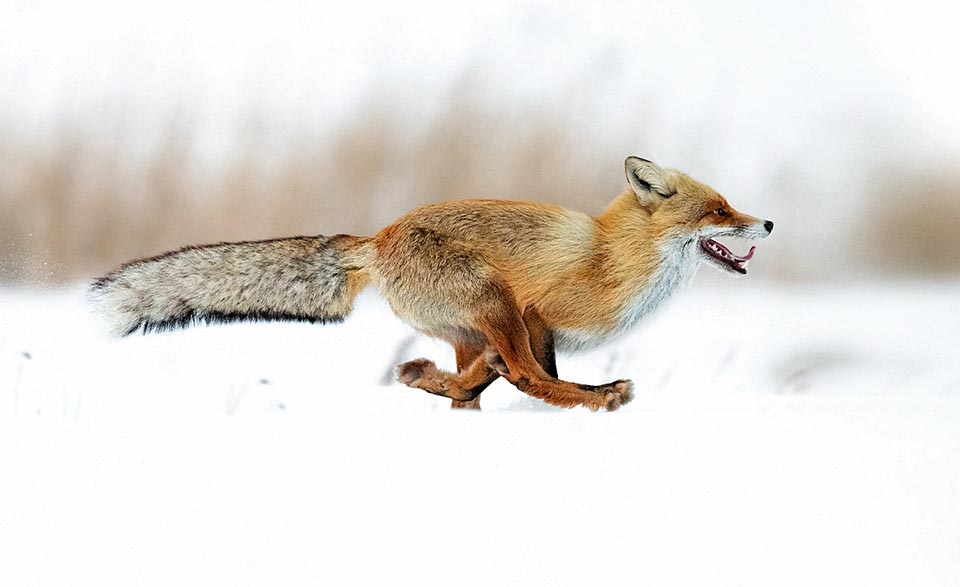
The length of body varies from 45 to 90 cm. The tail may measure 35 to 50 cm about and serves to balance the weight while running where it reaches the speed of 72 km/h © Fabio Da Dalt
The IUCN evaluates the red fox as an LC – Least Concern species due to its vast distribution and to its tolerance to a vast variety of habitats.
Although hunting is permitted, only and exclusively in the manner and terms established by law, this species is unlikely to suffer such a decline to place it in a threatened category.
A precise number of foxes present in nature is unknown, but it is estimated that the most probable average density stands at about 1-2,5 foxes per square kilometer.
Ecology-Habitat
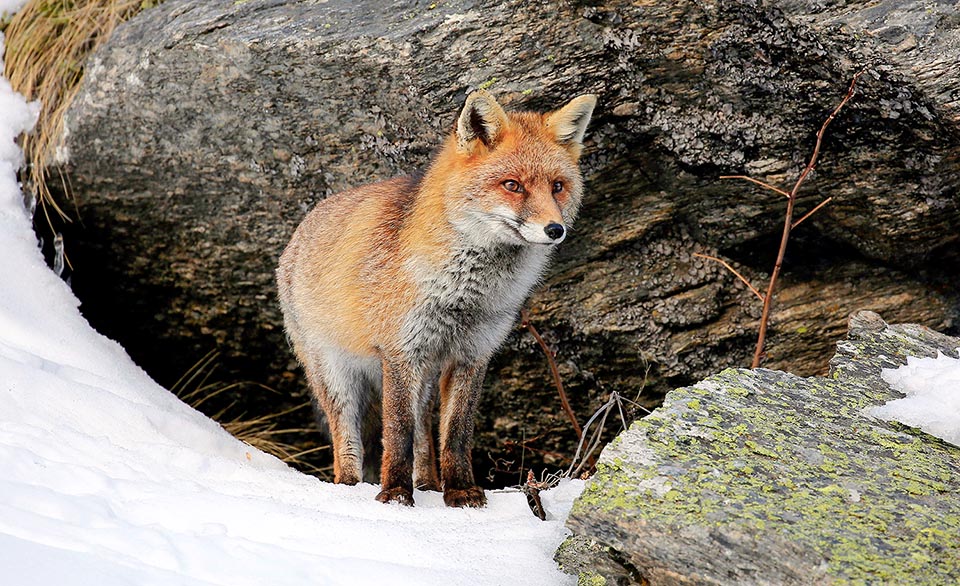
The weight varies from 2,5 to 14 kg, with males usually bigger than females. Moreover, it distinguishes from the other canids for the decidedly shorter legs © Daniele Porro
One of the most important characteristics of this species is its capacity to adapt to whatever type of environment, from the sea level up to the high mountains.
It loves the mixed and deciduous forests, forests of conifers, alpine meadows, areas of Mediterranean bush, river valleys and cultivated plains. However, the presence of the fox in urbanized environments is always more frequent, in the outskirts and in the green areas within the cities.
Such an approach to urban areas is by sure due to the search for food and is favoured by the opportunist nature of these animals that pushes them to take advantage of an ever-increasing presence of organic waste.
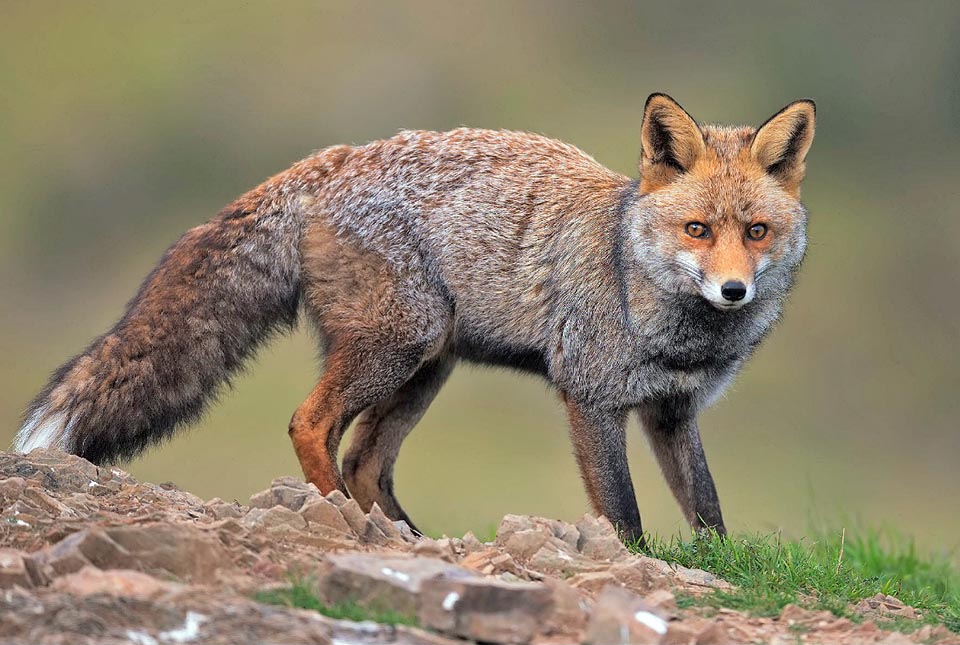
The fur displays a great chromatic variability, seasonal as well as geographical, very thick and soft especially in winter to stand very low temperatures © Alessandro Chiezzi
The red fox is mainly a nocturnal and crepuscular animal, but, if not disturbed, can be very active also during the day; it tends to take shelter in ample dens (that often are handed down for entire generations) dug by themselves or abandoned by badgers (Meles meles) or by porcupines (Hystrix spp.).
Morphophysiology
The red fox is a canid of medium size: the length of the body varies from 45 to 90 cm, whilst the height at the shoulder goes from 35 to 50 cm; the tail may measure 35 to about 50 cm and served to balance the weight during the run and the extraordinary jumps with which they can reach the three metres of height. The weight varies from 2,5 to 14 kg and the males are usually a little larger than the females.
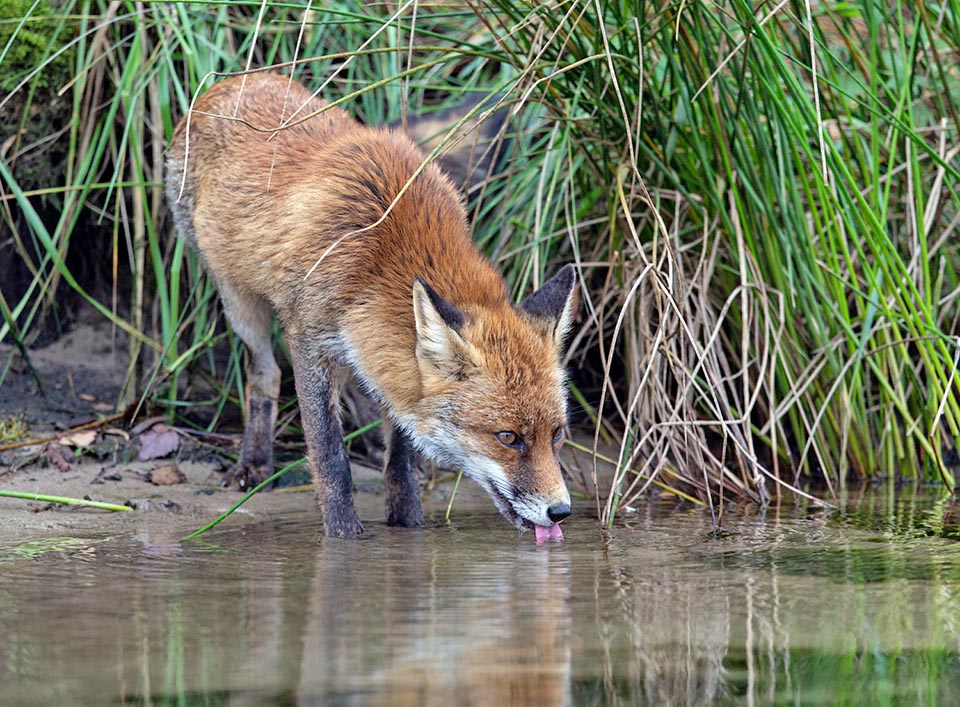
One of the most important characteristics of this species is its capacity to adapt to any type of environment, from the sea level up to the high mountain © Ron Winkler
These measures, quite variable depending on the different subspecies, render it the largest among the “foxes properly so called”, that is among all the members of the genus Vulpes. Moreover, it distinguishes from the other canids for its decidedly shorter legs.
It can be said that the foxes of the northernmost territories (Canda, Alaska, Scandinavia) are usually bigger than those of the southernmost areas of its range (North Africa, Middle East).
The dentition does not differ much from that typical to the canids, where each dental arch is characterized by the presence of six incisors, two formidable canines for capturing and holding the prey, eight premolars and four or six molars, used for crushing even the bones. However, in the fox, the dimensions of the teeth are proportionally smaller than, for instance, in the wolf or the jackal.
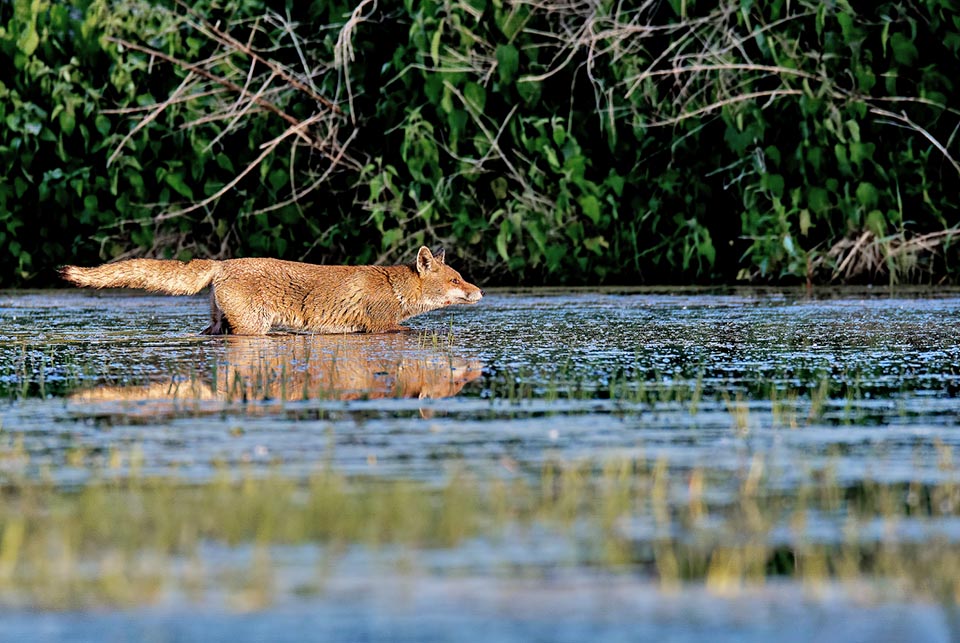
Here it is hunting in a swamp even if most of its preys do not live in aquatic environments © Gabriele Bartozzi
Its mantle is characterized by a great chromatic variability, seasonal as well as geographical and appears very thick and morbid, especially in winter, allowing the animal to stand very low temperatures.
These characteristics have attracted the interest of man since the ancient times for the creation of fox furs, so much that the animal was bred in captivity to increase their production. Lately this use is less and less frequent and more and more countries are forbidding the breeding and killing of animals with the purpose of obtaining furs.
As can be guessed from the common name, the fur of the red fox is chiefly reddish with hues going from yellow to brown, especially on the back, whilst the belly, the throat and the cheeks are grey-whitish, as well as the tip of the tail.
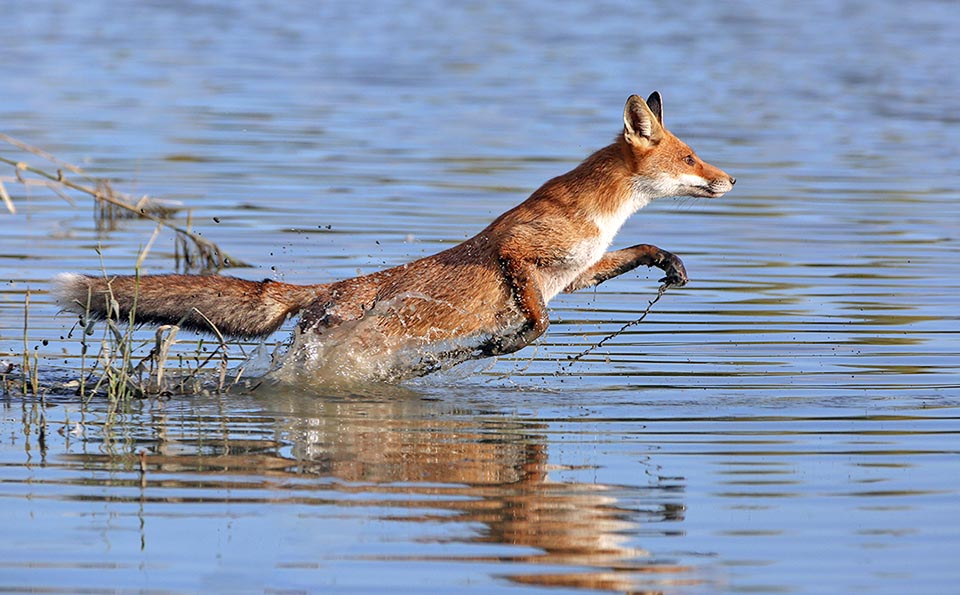
The fox shows in any environment an extraordinary agility with even 3 m jumps © Valeria Marchioni
The snout is particularly elongated, and the ears are triangular, very mobile and characterized by black hair together with the feet and the lower part of the tip of the tail. In Europe and in North America has been observed the presence of some rare specimens characterized by an almost black or dark grey mantle; this is the melanistic variant of this species, called “silver fox”, presently almost extinct because it was intensely hunted for its particular and extraordinary fur.
Ethology-Reproductive Biology
The red fox is classified as carnivorous and being a skilled predator, its diet is mainly based on animals of different dimensions and categories.
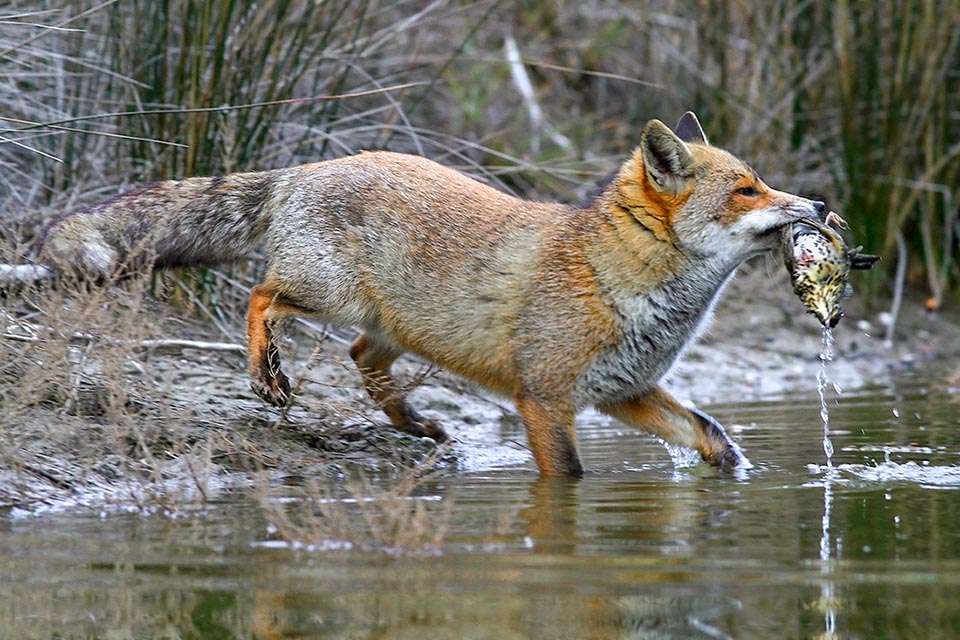
This one has just captured a song thrush while getting watered. When the loot is abundant, being provident, the fox may even bury the leftovers as a supply of food © Gianfranco Cinelli
Some examples of most frequent preys are: mice and voles (genera Mus, Apodemus, Arvicola, Microtus), shrews (genera Sorex, Crocidura), moles (Talpa spp.), slightly larger mammals such as dormice (Glis glis), rabbits (Oryctolagus cuniculus), hares (Lepus spp.) and some mustelids like the weasels (Mustela nivalis); several species of birds such as pheasants (Phasianus colchicus), partridges (Alectoris spp.), quails (Coturnix coturnix), and a vast number of passerines and their nestlings; finally, it goes hunting also small reptilians like lizards and blindworms, small snakes, amphibians and a great number of invertebrates.
A habit of pooling it to the other canids is that of going far and wide to its territory in a continuous “hunger march” guided by the smell and hearing. However, despite the classification, the fox is considered mainly as an omnivorous species and on top of that opportunist as, if necessary, eats also berries and wild fruits.
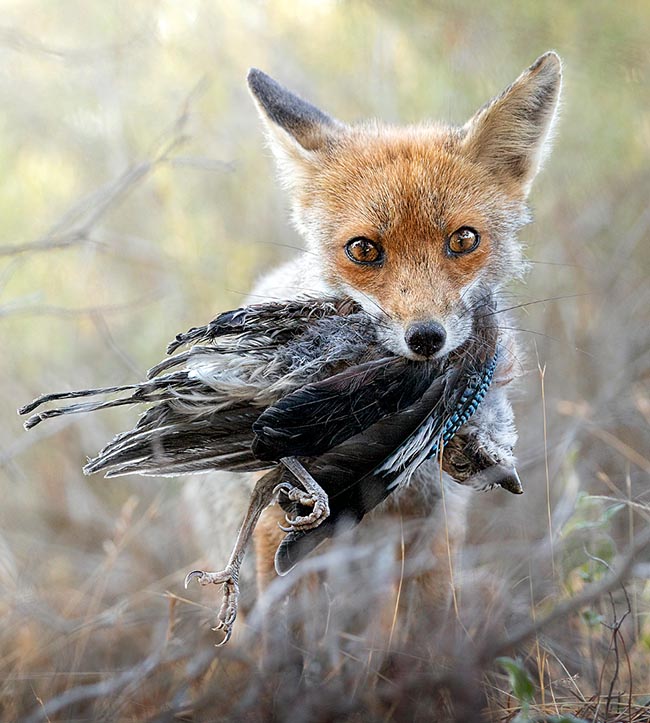
Conversely here the prey is an Eurasian jay © Fabiomassimo Turri
Its ecological role is fundamental also due to its activity as “scavenger” when it cleans up the environment nourishing of small carcasses.
This great adaptability to a diet so much rich and varied is by sure one of the reasons that have determined the ecological success of this animal.
The red fox has a stomach rather small compared to its size and can proportionally ingest much less food compared to that ingested, for instance, by dogs or wolves; the dose consumed daily varies from 0,5 kg to 1 kg of food.
Various behaviours of the fix are linked to the feeding, like, for instance, the strategy of setting aside the food supplies during the times of abundance, hiding them in many small 5-10 cm holes and not in only one place so as not to risk losing everything at once.
Usually they go hunting alone and, thanks to their extremely fine hearing, they detect the small preys and with ample and rapid jumps they can catch them, maintaining the suitable distances for not losing them.
As well as hunting, also the style of life is mainly solitary excepting the reproductive phase, during which it can live in couple or in small groups. In this period, the members of the same group communicate with each other by means of behavioural signals of the body and specific vocalizations depending on the necessities.
The fox is also a very territorial animal and defends its own space in couple during the winter and solitary in summer; in particular, the male marks the territory through secretions produced by odour glands located near the tail, communicating in such a way to the other individuals also its social position.
The mating season takes place in winter. Courting begins between December and January, when in the night can be heard fights and yelps between males, stimulated by the strong odour emitted by the females, whereupon mating takes place. After a gestation of about 50 days, in full spring, the female delivers three to five babies. After having prepared a soft couch in the bottom of its den, it gives birth to its puppies who initially will be deaf, blind, grey and almost as big as moles; after two weeks they start to open their eyes.
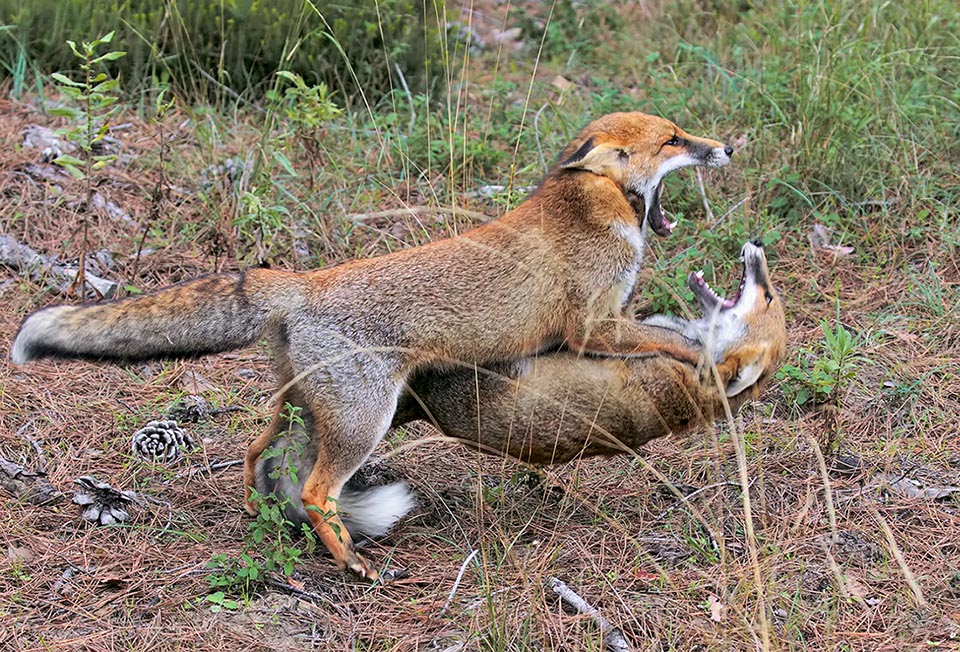
Especially in the reproductive time, stimulated by the strong smell emitted by the females, the foxes are particularly territorial and the scuffles between males are frequent © Maurizio Lanini
Breastfeeding lasts about one month and, during this phase, the mother almost never goes away from the offspring and it’s the male who brings the food to the den.
Later on, in the nourishment of the young the mother integrates also a part of predigested and regurgitated food, until weaning is gradually completed.
At this stage the puppies will be lively and soft greyish wads with a lighter band on the front and on the tip of the white tail.
In June they will begin to follow their parents in the search for food and around late summer the young males will leave the family nucleus for conquering their own territory in view of the following mating season.
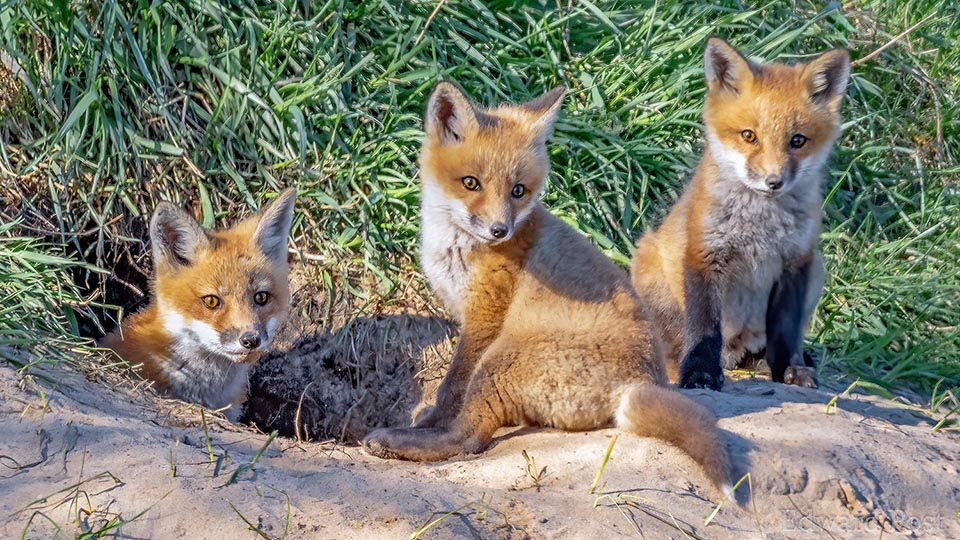
After an about 50 days long pregnancy, in full spring, the female gives birth to three to five puppies. Vulpes vulpes is not an endangered species © Ed Post
Despite their natural disposition is very shy and elusive, it is not difficult to find, especially in very touristic zones, foxes very confidant towards man and who get closer in exchange for leftovers.
This happens because the fox is an easily tameable animal using positive reinforcements, but this has negative consequences for the safety of the animal and of the entire species. In fact, in addition to the danger that lies in approaching man (not always well-intentioned) and the inhabited centres, also eating unsuitable foods may cause in the animal a physical impairment that would render it vulnerable to diseases like the rabies and the scabies that then could be diffused among the various individuals.
Synonyms
Canis vulpes Linnaeus, 1758, Vulpes palmaria Hay, 1917.
